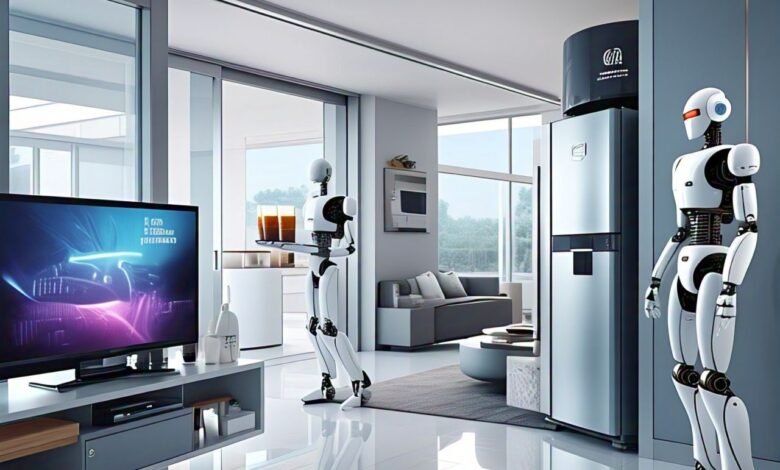The Rise of Smart Homes

Outline:
H1: The Rise of Smart Homes
H2: Introduction to Smart Homes
- H3: What Defines a Smart Home?
- H3: Evolution from Traditional to Smart Living Spaces
H2: Key Components of a Smart Home
- H3: Smart Lighting Systems
- H3: Intelligent Thermostats and Climate Control
- H3: Home Security and Surveillance Solutions
- H3: Voice Assistants and Central Control Hubs
H2: The Technology Behind Smart Homes
- H3: Internet of Things (IoT) in Smart Homes
- H3: Artificial Intelligence and Machine Learning Integration
H2: Benefits of Smart Home Technology
- H3: Enhanced Comfort and Convenience
- H3: Energy Efficiency and Sustainability
- H3: Improved Home Security
H2: Challenges and Concerns
- H3: Privacy and Data Security Issues
- H3: Cost and Accessibility Barriers
H2: Smart Homes and Daily Life
- H3: Smart Kitchens and Connected Appliances
- H3: Entertainment and Media Automation
H2: Future Trends in Smart Home Technology
- H3: Integration with Renewable Energy Sources
- H3: Rise of Smart Communities and Cities
H2: How to Start Building a Smart Home
- H3: Budgeting and Planning
- H3: Choosing the Right Devices and Ecosystem
H2: Conclusion
H2: FAQs
- H3: Are smart homes really worth it?
- H3: Can I make my existing home smart?
- H3: Do smart homes save money in the long run?
- H3: Is it safe to have everything connected?
- H3: What’s the first step to turning my home smart?
The Rise of Smart Homes
Introduction to Smart Homes
What Defines a Smart Home?
Smart homes—ever heard the term and wondered what exactly qualifies a house as “smart”? Think of it like this: your home learns your habits, listens to your commands, and responds in real time, often without you lifting a finger. Sounds like a sci-fi movie? It’s not. A smart home uses internet-connected devices to manage appliances, lighting, climate, security systems, and more, all remotely or automatically.
Imagine pulling into your driveway and your garage door opens, lights come on inside, the thermostat adjusts to your ideal temperature, and your favorite playlist starts—all without touching a single button. That’s the magic of a smart home. The real heart of it lies in automation, remote control, and connectivity.
It’s not just about being cool or convenient, though. Smart homes offer real-world benefits—saving time, energy, and sometimes even money. And as technology becomes more accessible, they’re no longer just for the tech-savvy or the ultra-wealthy. Smart homes are going mainstream, and this transformation is only accelerating.
Evolution from Traditional to Smart Living Spaces
Rewind a few decades, and homes were… well, basic. Lights were switched manually, security meant locking the front door and hoping for the best, and entertainment revolved around a TV with rabbit-ear antennas. But then came the internet, followed by smartphones, and suddenly the game changed.
The concept of smart homes started with simple gadgets—like programmable thermostats and automatic garage doors. Fast forward to today, and we’re talking about fully integrated ecosystems that can automate and personalize virtually every aspect of living. Thanks to innovations in IoT, AI, and cloud computing, homes now adapt to our routines, save energy when we’re away, and even notify us if something’s amiss.
This evolution didn’t happen overnight. It’s been a gradual but steady shift, driven by our increasing reliance on digital tech. Now, it’s not uncommon to see someone controlling their entire house from a smartphone—whether they’re at work, on vacation, or just too cozy in bed to get up and turn off the lights.
Smart living isn’t just the future—it’s the now.

Key Components of a Smart Home
Smart Lighting Systems
Let’s shine a light on one of the simplest yet most impactful smart upgrades—smart lighting. It’s not just about bulbs that change color (although, that’s fun too). Smart lighting systems let you control brightness, color temperature, and on/off schedules with your phone or voice.
Imagine waking up to lights that slowly brighten like a sunrise, or setting the perfect movie-night ambiance with a single command. Smart bulbs like Philips Hue, LIFX, or GE Cync offer these features and more. You can group lights by room, automate routines, and even sync them with your music or mood.
But the magic doesn’t stop at cool effects. Smart lighting helps save energy by turning off when no one’s around or adjusting based on natural daylight. Over time, that means lower electricity bills. Many systems also integrate with motion sensors, so your hallway light can turn on automatically at night when you walk by—no fumbling for switches.
And installation? It’s usually as easy as screwing in a bulb and connecting it to your Wi-Fi. Whether you’re a renter or a homeowner, smart lighting is one of the easiest and most affordable steps into the world of home automation.
Intelligent Thermostats and Climate Control
Heating and cooling—these are the real energy guzzlers in most homes. Enter smart thermostats. Devices like the Nest Learning Thermostat or Ecobee aren’t just programmable—they learn your schedule and adjust accordingly. If you leave for work at 8 AM, your thermostat knows when to dial things down. Come back at 6 PM? The house is cozy and warm by the time you walk in.
What sets these thermostats apart is their ability to adapt. They track when you’re home or away using geofencing or motion sensors. They also connect with weather services to fine-tune their settings based on the forecast. Over time, they optimize your energy use for maximum efficiency.
And yes, you can control them from your phone or just by saying, “Hey Google, lower the temperature.” This combo of control, learning, and energy efficiency can lead to significant savings. According to some reports, smart thermostats can cut heating and cooling bills by up to 20%.
So, beyond comfort, these devices are about control and cost-efficiency—helping both your wallet and the planet breathe a little easier.
Home Security and Surveillance Solutions
When it comes to feeling safe at home, smart technology has taken things to a whole new level. Traditional alarm systems have been replaced—or at least enhanced—by smart security systems that are more customizable, responsive, and easier to manage.
Smart security isn’t just about a camera on the porch. We’re talking about interconnected systems including smart doorbells (like Ring or Nest Hello), motion-detecting cameras, smart locks, glass-break sensors, and even AI-powered facial recognition features. These tools allow homeowners to monitor their property from anywhere in the world in real-time. Forgot to lock the front door? Just tap your phone. Someone’s lurking near your back gate? You’ll get an instant notification.
What’s even cooler is that many systems now integrate with other smart home features. For instance, if your smart camera detects motion at night, it can automatically turn on your porch light and start recording. Some systems even alert the police or a private security service if something fishy is detected.
And then there’s video storage—cloud-based systems allow you to review footage anytime, without worrying about clunky DVRs or physical hard drives. Plus, these systems often offer analytics: get alerts only for what matters, like when a person is detected instead of your neighbor’s cat walking by.
For those concerned with privacy, reputable smart security brands offer strong encryption and multi-layered authentication. Still, it’s important to choose wisely, stick to trusted names, and always update your devices regularly.
In short, smart home security gives you peace of mind without being invasive or complicated. Whether you’re away on vacation or just out running errands, you’re always connected to what matters most—your home.
Voice Assistants and Central Control Hubs
Say hello to the command center of your smart home—voice assistants and hubs. You’ve probably heard of Alexa, Google Assistant, or Apple’s Siri. These AI-powered helpers are the heart of most smart home ecosystems, turning voice commands into real-world actions.
Want to dim the lights, lock the doors, check the weather, or play your favorite Spotify playlist? Just ask. With a single phrase like, “Hey Alexa, good morning,” you can trigger an entire routine: blinds open, coffee brews, thermostat adjusts, and your news briefing plays—all without lifting a finger.
Beyond convenience, these assistants can serve as control hubs, linking together devices from different brands and making them work seamlessly. For instance, you might have a Nest thermostat, Philips Hue lights, and a Ring doorbell. Using a central hub like Amazon Echo or Google Nest Hub, you can control all of them from one place.
What’s more, these systems are constantly evolving. With regular updates, your assistant gets smarter over time, understanding context better, handling more complex commands, and even learning your preferences.
Some hubs also come with touchscreens, making it easy to view camera feeds, control music, or browse recipes. Others integrate with your TV or home theater, turning your voice into a remote control for everything.
Of course, privacy is a hot topic. Voice assistants are always listening—for wake words. But most have options to mute the mic or manage data sharing, giving you some control over what’s recorded.
Think of these assistants as your home’s concierge—ready to help 24/7, always on standby, and surprisingly good at learning your habits.
The Technology Behind Smart Homes
Internet of Things (IoT) in Smart Homes
At the heart of every smart home is a network of connected devices, communicating through something called the Internet of Things—or IoT for short. It sounds techy, but the idea is simple: everyday objects, from fridges to lightbulbs, are embedded with sensors, software, and Wi-Fi capability so they can interact with each other and with you.
Let’s break it down. Your smart thermostat detects you’re not home (using geolocation or motion sensors), so it signals the heating system to lower the temp. Meanwhile, your smart blinds close automatically to block out the sun and conserve energy. All of this happens without you doing a thing. That’s the beauty of IoT—automation and interconnectivity.
IoT turns your home into an intelligent ecosystem. Devices collect and share data to improve their performance, anticipate needs, and deliver personalized experiences. For instance, your fridge can tell you what groceries you’re running low on, or your washing machine can notify you when a cycle is complete.
The real magic lies in the seamless connection. IoT systems use wireless protocols like Wi-Fi, Zigbee, Z-Wave, or Bluetooth to stay connected. And when integrated with cloud computing, these devices can be monitored and controlled from virtually anywhere on the planet.
But it’s not all roses—IoT does come with security concerns. More connected devices mean more potential entry points for hackers. That’s why securing your network, updating firmware, and using encrypted services is key to keeping your smart home safe.
Still, the power of IoT is undeniable. It’s what transforms a collection of smart gadgets into a truly smart home.
Artificial Intelligence and Machine Learning Integration
Smart homes don’t just respond anymore—they learn. Thanks to artificial intelligence (AI) and machine learning (ML), today’s smart home systems are more intuitive, adaptive, and personalized than ever.
Let’s say your smart thermostat notices that every Wednesday you get home later and prefers a cooler room. Over time, it’ll adjust the temperature before you even open the door. That’s machine learning in action. Or your lights gradually learn when to dim during movie nights. AI is the brain behind those subtle, helpful changes.
Voice assistants are the most visible example of AI in smart homes. They understand your speech, interpret your commands, and even respond in a conversational way. With ML, they get better over time—learning your preferences, improving speech recognition, and anticipating what you might want.
AI also plays a huge role in smart security. Facial recognition technology helps distinguish between your family, friends, and strangers. It can even recognize suspicious behavior patterns and alert you instantly.
And don’t forget smart appliances. AI can recommend recipes based on what’s in your fridge, or alert you when the laundry needs attention. Smart vacuums like Roombas learn the layout of your house and optimize cleaning paths. AI turns these once-basic devices into intelligent, efficient helpers.
Of course, with great intelligence comes great responsibility. AI in smart homes raises ethical and privacy questions—how much should your devices know about you? But when used responsibly, AI and ML enhance the smart home experience in ways we only dreamed of a decade ago.
Benefits of Smart Home Technology
Enhanced Comfort and Convenience
Imagine a home that anticipates your needs before you even think about them. That’s the comfort level smart homes offer. Whether it’s your coffee machine starting at 7 AM sharp, lights adjusting to the time of day, or music following you from room to room, smart tech delivers a seamless experience tailored to your lifestyle.
Convenience is at the heart of it all. With a simple voice command or a few taps on your phone, you can manage everything from your thermostat to your robot vacuum. Forgot to turn off the lights before leaving? No worries—do it from your car. Need to let a delivery person in while you’re at work? Unlock the door remotely and monitor everything via live video.
Routines become automated. With scheduled lighting, heating, and security, you eliminate repetitive tasks and free up time for what matters most. Even better, smart homes are accessible for everyone—including the elderly and people with disabilities. Voice-activated controls and automation help them navigate daily tasks more independently and safely.
Plus, with integrations that span across devices and platforms, your home becomes a unified ecosystem. Everything is connected and works together to make your life easier, smoother, and a whole lot more comfortable.
Energy Efficiency and Sustainability
If there’s one thing smart homes excel at—besides convenience—it’s energy efficiency. From smart thermostats that learn your habits to lights that turn off automatically when you leave the room, these systems are designed to reduce waste and lower utility bills.
Let’s talk numbers. A smart thermostat alone can reduce heating and cooling costs by up to 20%. Smart lighting systems use LEDs, motion sensors, and scheduling to ensure lights are only on when needed. And smart plugs help you cut off phantom energy usage from devices left plugged in but not in use.
Smart irrigation systems for your garden adjust watering schedules based on weather forecasts and soil moisture, conserving water while keeping your plants happy. Even appliances like washing machines and dishwashers now feature eco-friendly modes that adapt based on load size and water availability.
Then there’s the broader impact—reducing your carbon footprint. By using less energy and optimizing resource consumption, smart homes contribute to a more sustainable lifestyle. Combine smart tech with renewable energy sources like solar panels, and you’re not just saving money—you’re helping the planet.
The key takeaway? Smart homes aren’t just about tech—they’re about smarter living, both for you and the environment.
Improved Home Security
When it comes to peace of mind, nothing beats knowing your home is secure—and smart homes take that security to the next level. No more worrying if you left a door unlocked or if a window is open. Smart sensors, cameras, and locks keep everything under control and in check.
Let’s start with smart locks. These let you lock or unlock your doors from anywhere, assign virtual keys to guests, and track who comes and goes—all from an app. Want your cleaning service to enter only between 10 AM and 12 PM? You can set that up in minutes.
Then there are smart cameras and doorbells. Get instant alerts when someone approaches your door. See who it is via live video. Even talk to them remotely. Whether it’s a delivery person, neighbor, or potential intruder, you’re always in the loop.
Motion detectors and glass-break sensors provide added layers of protection. If something out of the ordinary happens, your system will alert you—and even contact emergency services if needed. Some systems come with facial recognition and AI analysis to reduce false alarms and identify actual threats more accurately.
Many insurance companies now offer discounts for homes with smart security systems. That’s right—you can save money just by keeping your home safer.
In short, smart homes give you real-time awareness, complete control, and the confidence that your family and possessions are safe—day or night.
Challenges and Concerns
Privacy and Data Security Issues
With all this connectivity and convenience comes a major concern: privacy. Smart homes collect a ton of data—when you come home, how often you use your appliances, what you watch, even the sound of your voice. And while that data is what makes these systems “smart,” it also opens up potential vulnerabilities.
Data breaches are a real threat. If not properly secured, your smart home devices could be hacked, allowing intruders to spy, unlock doors, or tamper with your settings. It’s a scary thought, but one that shouldn’t be ignored.
Then there’s the issue of companies collecting and using your data. Some use it to improve services, while others might sell it to advertisers or third parties. This raises ethical questions about surveillance and the boundaries between convenience and intrusion.
So how can you protect yourself? Start with strong passwords and enable two-factor authentication on all your devices. Keep your firmware and apps updated. Use secure Wi-Fi with a good router and consider separating your smart devices on a guest network.
Also, read privacy policies before buying. Choose reputable brands that value user security and offer transparency in how your data is handled.
While privacy concerns shouldn’t stop you from enjoying smart tech, they should make you more aware. With a few precautions, you can enjoy all the benefits of a smart home without sacrificing your personal security.
Cost and Accessibility Barriers
Let’s be honest—building a smart home isn’t cheap. Sure, you can start with a smart bulb or plug, but a fully integrated system with security, lighting, climate control, and automation? That can run into the thousands.
The cost of devices, installation, and ongoing maintenance can be a barrier for many people. And while prices are gradually dropping, smart home tech is still seen as a luxury by many, especially in lower-income households.
Beyond cost, there’s the issue of accessibility. Not everyone is tech-savvy. Setting up and managing smart devices requires some level of technical know-how. For older adults or those unfamiliar with apps and connectivity, the learning curve can be steep.
Another consideration is compatibility. Not all devices work well together, especially if they’re from different brands. This can lead to frustration and extra costs as users replace or upgrade systems to ensure smooth integration.
But the good news? It’s getting better. Many companies now offer starter kits that are easy to set up, affordable, and expandable. Voice control has also made smart homes more accessible to those with physical disabilities or mobility issues.
The future of smart homes lies in affordability and simplicity. And while we’re not quite there yet, the industry is clearly moving in that direction.




